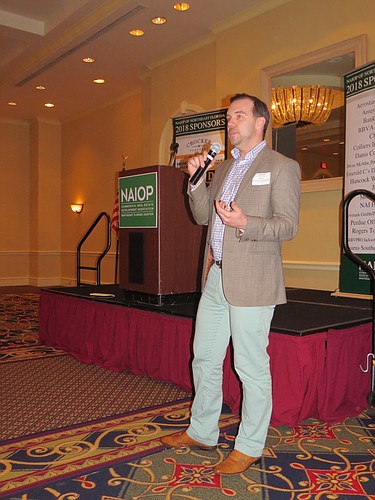
Consumer expectations are continuing to trend toward more, better and faster.
That’s no different for companies who need to adapt their office space to maximize the blend of artificial intelligence and human production in the workplace.
Joel Schellhammer, vice president of corporate strategy with Steelcase, told Northeast Florida members of NAIOP on Thursday that office space providers need to begin thinking of their clients as consumers holding similar expectations for the continuing evolution of the workplace.
Just as Amazon.com Inc. customers expect shipments in days, if not hours, companies are beginning to need smart, adaptable office space designs delivered in weeks rather than months.
In the transition, owners of existing commercial space are caught between the decades-old concept of office space design and the adaptability expectations not only of companies, but also of their employees.
That’s a fundamental shift in the business-to-business culture.
It presents a particular challenge for providers of brick-and-mortar to companies attempting to keep pace with their own customers’ expectations of immediacy, and whose own needs are changing in the process.
“The B-to-B environment is different from the consumer environment,” Schellhammer said.
“It used to be we could think that way, but more and more people are saying it has to stop being that way,” he said.
Almost 90 members of the NAIOP Commercial Real Estate Development Association Northeast Florida chapter attended the lunch at the Jacksonville Marriott.
Schellhammer told them that companies unable to understand that their clients have the same expectations as consumers “are going to fall further and further behind.”
Schellhammer, whose professional background includes both consumer-oriented and business-to-business disciplines, has led Steelcase through a yearlong exploration of the company’s changing commercial and industrial clientele.
That research resulted in four key evolutionary factors in the workplace and three approaches to address those changes.
The first trend is “consumerization of industry.”
“How can I understand you so well that I can meet your needs specifically?” Schellhammer said.
“Technology has enabled us to do that and now we all expect that. That’s bleeding over into the office environment as well.”
The second trend is speed. Netflix has intuitive software that allows it to present programming the user wants before he even asks for it, Schellhammer said.
Amazon can store and recall cognitive data that allows it to display the customer’s preferences at login. Business demands for office space are similar, he said.
Companies need space designed to accommodate not only their employees, but also their hardware, space that instantly is adaptable because of the rapidly changing nature of most businesses.
CEOs, he said, frequently express that they know what their companies are today, but have no idea what they will be 10 years from now.
Schellhammer said the third trend is in not only meeting current needs, but anticipating and rapidly adapting to changes in those requirements.
“CEOs say, ‘I need 400 people to be in a new space in 30 days.’ That means finding the space, getting it built-out, get finishes in and ready for lease,” Schellhammer said. “That expectation is only going to get faster. The reality is they don’t know how long they are going to need it. They don’t want to sign a long-term lease. They only need to know what they will do for the next six to 12 months. That’s a totally different functionality.”
The fourth trend is the impact of artificial intelligence and automation. While artificial intelligence will eliminate some jobs, those that remain will include a fusion of artificial and human intelligence, and creating spaces where both can function harmoniously will be a constant challenge.
“Almost every CEO I talk to has no idea how AI will impact their business, but they know it will,” said Schellhammer.
What will this mean for office space?
“First, there is no question we are moving toward office spaces that are more tailored and personalized to individual needs,” he said, adding that he sees a shift toward a greater level of employee influence on how the spaces are designed.
To meet the challenges, Schellhammer foresees the rise of co-design, where employees will participate in the design of their workspace.
Those spaces will reflect changes in human behavior. There will be more displaced employees in the workforce, but those that work in office environments will have greater choices as the necessary human intelligence wields more influence.
“We talk about what we see as a rising trend in that they want choice and control in their office spaces,” said Schellhammer.
“They can choose how or where to work. This desire for choice and control is really significant and will have a big impact on how spaces are designed,” he said.
Finally, the blending of space and technology will intensify, requiring a new approach to office space design to accommodate new ways to work. “The space itself will actually augment performance,” he said.
All of it will have to be done at a lower cost as companies gain leverage by requiring less square footage as a result of automation, increasing competition for their business.
They also will be value conscious as their human resources costs rise to meet the demands of a higher value workforce.
Schellhammer said the pressure on the market is to lower the cost per square foot.
“The balance of power is shifting to favor employees, and the reason is as artificial intelligence starts to pick off jobs that are lower value, the employees who do remain will become increasingly high value. You will start to see higher investments in the space,” he said.
“Employees will go to companies that can offer the best spaces,” Schellhammer said.